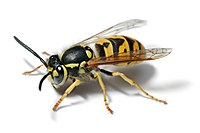
Photo from wikipedia
Abstract The level of habitat specialization is informative in terms of animals’ population status and conservation concern. Therefore, identifying the areas where specialist species are aggregated and understanding the ecological… Click to show full abstract
Abstract The level of habitat specialization is informative in terms of animals’ population status and conservation concern. Therefore, identifying the areas where specialist species are aggregated and understanding the ecological constrains that might shape their distribution has become an important issue. In this sense, we tested whether specialist communities are more likely to succeed in milder and stable environments or in more extreme and less predictable environments. For that purpose, we used data from the EBCC atlas of European breeding birds and for each of 50 × 50 km grid cells calculated community specialization index (CSI). We expressed CSI in two ways: as a mean (CSIMEAN) and a standard deviation (CSISD) across species in a given cell. We used generalized least squares (GLS) models to relate these measures to geographic variables (latitude, longitude and altitude) and climatic variables (temperature and rainfall) across Europe controlling for possible confounding effects of habitat heterogeneity and human-induced land cover conversion. We identified two areas, Scandinavian Peninsula and the steppe regions north of Caucasus, where bird communities are highly specialised. GLS models showed that habitat specialization generally increased with altitude and this pattern was broadly shared by the CSIMEAN and CSISD. Concerning climatic variables, we found that specialist spatial distribution was significantly related to extreme temperatures and lower level of precipitation. Our results thus suggest that European specialist birds are found mostly in strongly seasonal, dry and cold environments. Thereby, preserving these sensible environments from further perturbations might be the key for the specialist conservation.
Journal Title: Ecological Indicators
Year Published: 2019
Link to full text (if available)
Share on Social Media: Sign Up to like & get
recommendations!